How to Grow Organic for Beginners

While eating organic is healthy for you and your family, it can get expensive to buy organically raised fruits and vegetables at the market. Have you ever considered starting your own organic garden to grow your own vegetables and don’t know where to begin? Starting a garden does not have to be intimidating; in fact, it can be relaxing and fun!
Where does your garden grow? Considering your space.
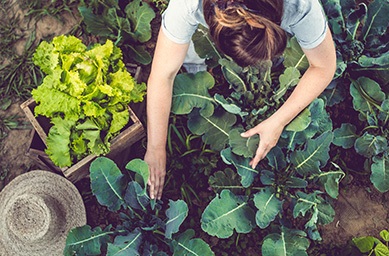
The first consideration when planning your first garden is the space available to you. Surprisingly, you don’t have to have a huge area to be a successful gardener. In fact, you can even grow organic vegetables in containers on your porch or build a raised garden bed in the corner of your yard. The other important thing to consider as you’re starting out is how much time you have to care for your garden and not go too big at first.
When selecting your first garden space, keep in mind:
- Sunlight – your plants will need 6-8 hours of sun per day
- Water Source – find a location near a water source so you don’t have to lug water containers
- Visibility – if you can see your garden, you’ll be reminded to care for it
What’s best in your vegetable garden? Things you like on your plate!
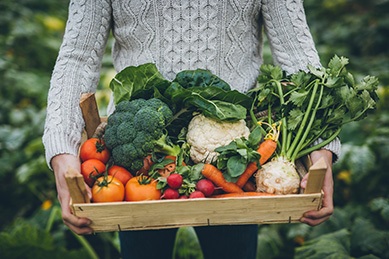
When thinking about what you want to grow, the most important thing to consider is what you and your family like to eat. Even with a small garden, it’s a successful harvest will yield more than you can eat, so staying focused on vegetables and herbs you can preserve, vacuum seal or share with friends and family is a great idea.
Additionally, you’ll need to be realistic about your region and what plants work best where you live. The USDA Plant Hardiness Zone (https://planthardiness.ars.usda.gov/PHZMWeb/) is a good starting point when researching potential vegetables to grow. Selecting plants that adjust well to your area’s light, moisture, drainage and soil quality will help keep your garden healthy and resistant to disease or attack, which is really important when growing naturally.
For beginning gardeners with limited space and time, some of the easiest plants to grow are:
- Old-fashioned pole beans
- Zucchini
- Swiss chard
- Tall snow peas and sugar snaps
- Indeterminate tomatoes (such as Big Boy, Beefsteak and Sungold)
It’s all about that base. Good soil is the key to success.
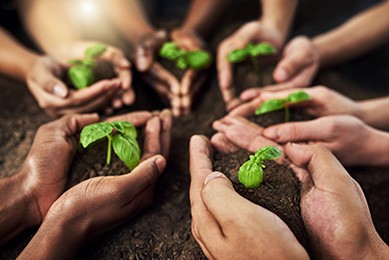
Regardless of your experience level, the biggest determinant of gardening success is your soil. Rich, healthy soil builds stronger plants that are less prone to disease. To start your new garden off right, it’s critical to know your soil and be sure it’s properly conditioned, before you plant the first seed.
One of the best ways to get to know your soil is by having it tested. You can purchase a soil test kit at your local garden center, or have your soil tested (for free or at a small fee) by your local cooperative extension service. While the soil test will not tell you specifically what crop to grow, it will tell you what your current pH levels are, the fertility levels of the principal nutrients and what nutrients need to be added to your soil for optimal growing. The best time to test your soil is in the fall, then apply any organic nutrients that you need before winter.
If you don’t already have a compost pile started, now may be the time to consider one. Composted material will provide your garden with the richest organic nutrients that you can find, naturally. It’s an inexpensive and environmentally friendly way to enrich your soil, and it’s easy.
When beginning to prep your space, make sure that the soil is not too wet. If you can form a ball in your hands with the soil and it does not break apart when tossed in the air, it’s too wet and needs 2-3 days before tilling.
Now it’s time to use a little muscle and get dirty! Prepare your garden bed by turning your soil 12-18”. Mix in your compost, manure or other organic fertilizer with your ground soil to create the perfect garden space and get ready for planting.
Raised garden beds can be more expensive than planting directly in the ground but are a bit easier to care for long-term. In addition to keeping weeds and critters under better control, raised beds help you control the quality of your soil and avoid contaminants that can be underground.
To seed or not to seed? Getting your garden started.
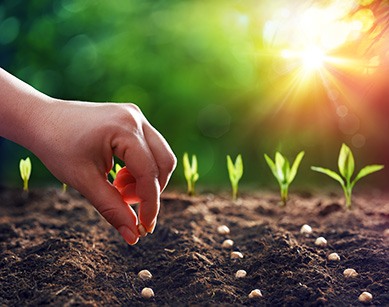
Beginning gardeners often wonder if it’s best to begin with small plants purchased at your neighborhood garden center or take the time to grow directly from seed. Most garden veggies can be grown from seed right in your garden bed, such as:
- Lettuce
- Beans
- Carrots
- Beets
- Chard
- Spinach
- Peas
- Cucumbers
- Squash
For crops that take longer to mature (like tomatoes, peppers, eggplant or melons), starting with small plants is a better approach.
When starting from seed, be sure to purchase high-quality seeds to offer a better likelihood of germination. Quality seed is also free of contaminants like soil particles, insect casings and possibly weed seed. Pick plants that will ultimately thrive in your growing region (remember the USDA Plant Hardiness Zone).
Depending upon where you live and the time of the year, it may be better to start your seeds inside and then gradually move healthy seedlings out into the garden within 6-8 weeks. In warmer climates, you can sow seeds directly into the ground in March or April.
Getting down and dirty. Planting time in the garden.
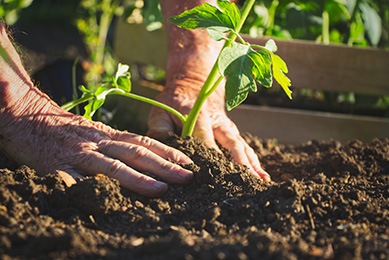
Digging in the dirt and getting your garden started can be a lot of fun. Be sure to collect the tools you need to make your life easy in coming weeks, like a trowel, clippers, garden gloves and a watering can (or a nearby water source and a quality natural rubber garden hose).
Most experts recommend planting rows north to south in your garden, to allow for maximum sun exposure and air circulation. In areas where summers are extremely hot and some shade is necessary, this is not as important. Organize your garden with the taller plants on the north side and shortest on the south, so the tall ones won’t “throw shade” on the little guys.
Follow directions on your seed packets for further instructions on proper spacing guidelines for each vegetable, as they are different. Correct spacing encourages good air flow and circulation, helping reduce the risk of fungus or other diseases. If plants are spaced too far apart, weeds can quickly take over.
As your seeds grow into seedlings with one or two sets of true leaves (2-3” tall), prevent overcrowding by thinning out your garden to allow room for proper growth and reduced competition for nutrients and water. It’s best to pull and leave a few inches of space between plants while the soil is damp, to keep from disrupting surrounding plants. Thinning in the evening gives plants time to adjust before exposure to heat and sunlight.
Let it flow (but not too much). Best ways to water your garden.
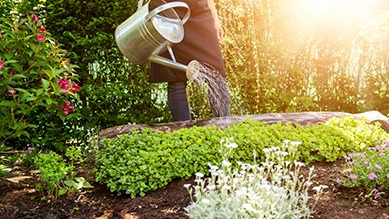
As a new gardener, knowing exactly when to water may seem stressful, but it is not as complicated as you might think. Generally, your garden should get an inch or two of water each week with an infrequent, deep watering session being preferred over shallow, frequent sips. Deep watering will help to build strong roots, which creates healthy plants.
There are other factors to consider that will influence your watering habits. First is your soil type. If your soil is sandy, water will evaporate faster than a clay soil, which is another reason why it’s important to incorporate compost into your planting bed. Applying a hearty 3-4” layer of mulch will also help keep moisture in and prevent weeds.
Weather conditions will also have an effect on your watering patterns. If you’re in a hot and dry climate, you’ll need to water more often. If its rainy, little watering is needed. It’s best to water in the morning, when it’s cooler outside and evaporation is reduced. Watering at night can lead to fungus and bacterial disease, because plants will remain damp for long periods overnight.
Finally, different plants in your garden will have different watering needs. Your seed packets will advise on proper care. Seeds should be kept consistently moist until they germinate. Plants should be watered carefully by hand or using a drip system, watering the roots and not the greenery.
Keep your water at room temperature and water from a quality natural rubber garden hose. If you’re in a rainy climate and feeling really inspired, rain barrels offer an affordable and earth-friendly alternative to the water tap.
Pull! Keeping weeds to a minimum in your garden.
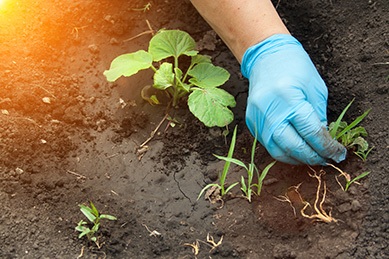
Let’s face it, no matter how great your soil is and how precisely you follow the directions on the seed packet, weeds are going to happen. The most important thing to remember when it comes to weeds is to not let them get away from you. Weekly weed pulling should become a part of your gardening routine. In fact, hand pulling weeds can actually be good exercise (trying to put a positive spin on things!).
In all reality, there are a few things you can do to help minimize your weed situation. The first would be to apply a layer of mulch about two inches deep (any deeper can deprive the soil of oxygen). The best time to pull weeds is after a rain shower when the soil is moist, and young weeds pull much easier than established ones.
If you’ve got weeds in an area outside the garden that you need to eliminate, consider a non-selective weed killer like Earth’s Ally Weed & Grass Killer, which is deadly to weeds (and all green things, so use caution) but safe to use around kids and pets.
A buggy situation. Protecting plants without harmful pesticides.
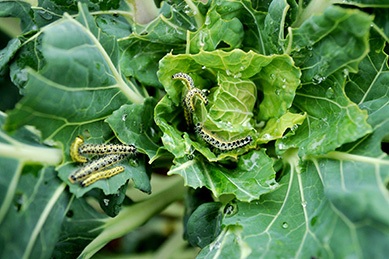
The best defense against pests in your garden is keeping your plants healthy, but at some point, most gardeners will have to do battle with insects or disease in their garden. The first thing to do when you notice an unwelcomed guest is to determine the problem. You may have an issue with moisture, nutrients or light that is causing your crop to be weak and susceptible to pests.
Once overall care of your garden is considered, start looking for signs of damage or symptoms of disease and noting common damage characteristics, which may be chew marks or spots on leaves, discolorations or even waste left behind. Also, keep in mind that about 95% of uninvited guests in your garden are harmless and can even be helpful (beneficial insects).
A few of these beneficials include:
- Ladybugs – control aphids and whiteflies
- Ground Beetles – control slugs, caterpillars and cutworms
- Soldier Beetles – control grasshopper eggs, aphids and soft-bodied insects
- Wasps – control caterpillars and aphids
- Bees – assist with pollination
- Butterflies – assist with pollination
When you’ve identified the characteristics or even seen the pesky creatures with your own eyes, you can visit our Common Pests page, consult with your local extension service or visit websites like the University of Florida Insect ID Lab to attach a name to your unwelcome guests and learn about ways to get rid of them. One of the safest ways to eliminate insects in your garden is with Earth’s Ally Insect Control.
If insects are not present but spots or other discolorations are occurring, your plants could be battling disease. Many garden diseases are caused by too much moisture, overwatering or even nutrient deficiency. Disease can be more difficult to diagnose than insects, and once plants are affected, things can quickly become out of control.
Once you’ve identified the bacteria or virus affecting your garden through identifying its symptoms, it’s important to cut off the affected leaves (or even remove the affected plant entirely) and destroy them. Do not add these clippings to your compost pile, as they can spread. Also, be sure to sanitize your clippers and other equipment to keep disease from spreading.
To control plant disease or prevent it from starting, you can use organic products safely without harming yourself, your family and pets, or the environment. Many garden enthusiasts have turned to organic pest and disease removal methods because of growing concerns about synthetic pesticides and their harmful effects. Using an OMRI Listed® product like Earth’s Ally Disease Control offers a much safer alternative that can be used regularly as a preventative to keep disease from making an unwanted appearance in your new garden.
Harvest time is here. Get ready to share!
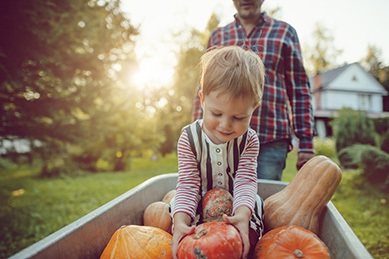
There’s nothing quite like the first harvest for the great feeling you get, knowing that your time in the garden has been time well spent. During peak season, check your garden every day for progress. Herbs are best picked during the mid-morning hours as they are needed or right before flowering to capture the best flavor. Leafy greens like kale and spinach can be harvested a little at a time from each plant every day, pulling the larger outer leaves so the smaller center leaves can have space to grow. For broccoli, wait until the central head is as big as it will get and the little buds (those pesky things you can get stuck in your teeth) are tight, then cut with a pair of scissors or garden shears, about 6-8 inches down the stalk. When harvesting, it’s always best to cut produce with a knife, scissors or shears to avoid tearing and causing tissue damage.
Your garden may produce more vegetables and fruits than you and your family are able to eat! If that’s the case, be prepared with canning supplies and other ways to preserve, such as a vacuum sealer and a freezer. A lot of your harvest will be coming in at once, so to avoid waste be prepared with ways to save or share with friends and family.
You made it! Time to prepare for next season.

Getting through your first gardening season is reason to celebrate learning something new and maintaining your own food supply. As fall approaches and the growing season comes to an end, be sure to clean up in your garden by removing all weeds and diseased plants from your bed, roots and all. This keeps pests and disease out of your planting space and gives you a good start on a healthy, clean space for next season.
Most of your healthy plants and root vegetables can be left in place over winter to offer a food source for local wildlife and to keep your soil from eroding. Use leaf mulches over your garden soil to keep it moist and holding nutrients that will have your soil reach and ready for growing when spring arrives and it’s time to get gardening again.
